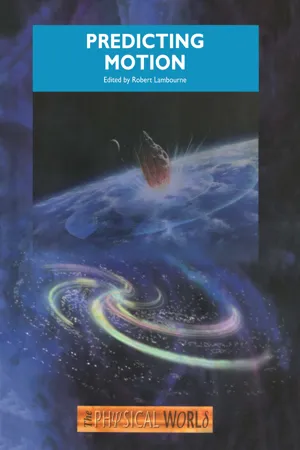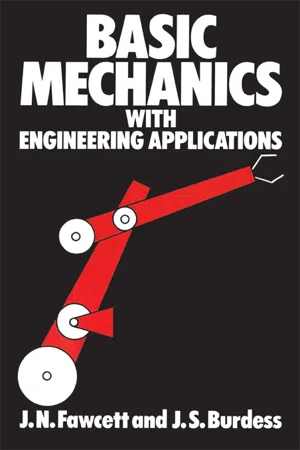Physics
Angular Impulse
Angular impulse is a measure of the rotational motion of an object, calculated as the product of the torque applied to an object and the time over which it is applied. It represents the change in angular momentum of the object and is important in understanding how forces cause rotational motion.
Written by Perlego with AI-assistance
Related key terms
5 Key excerpts on "Angular Impulse"
- Paul Grimshaw, Neil Fowler, Adrian Lees, Adrian Burden(Authors)
- 2007(Publication Date)
- Routledge(Publisher)
direction). Usually, we are normally concerned with rotation about one axis of rotation and it is applicable therefore to refer to angular momentum about a single origin or a single axis of rotation. In this manner we can consider it as a scalar quantity where we refer to its direction as either positive (anti-clockwise rotation) or negative (clockwise rotation). In addition, it is worth repeating that the total angular momentum of a body about any axis of rotation is made up by adding all the angular momenta of the various parts or segments of the body which are rotating about that axis. Within biomechanics this has important implications for understanding human movement and in more complex analyses the study of angular momenta about multiple axes of rotation is required.As we have seen, a net torque (that is not zero) that acts on an object will cause an angular acceleration of the object in the direction of the net torque. The amount of net external torque will equal the rate of change of angular momentum (i.e., from the angular analog of Newton’s second law).The change in angular momentum of an object can be determined by examining the initial and final angular momentum possessed by the object: Change in angular momentum = Angular momentum (final) − Angular momentum (initial) Thus we can now include this in the equation for torque: Mathematically this can be expressed as: Rearranging this equation produces the following: T(net) × (t2 − t1 ) = L(f) − L(i) This can now be expressed as the equation for Angular Impulse: This equation has important implications for the effective execution of rotational movements with human motion.Application
Considering the diver inFig. C2.3- eBook - ePub
- Steve McCaw(Author)
- 2014(Publication Date)
- For Dummies(Publisher)
i (read as “final angular momentum minus initial angular momentum”), describes a change in the angular momentum of a body. The equation shows that an applied Angular Impulse can increase or decrease the angular momentum of the body over the time period.The equation is similar to the impulse–momentum relationship for linear motion explained in Chapter 6 . The big difference is that both I and ω can change while the Angular Impulse is applied, while in linear motion the mass stays constant and only the linear velocity can change.Passage contains an image
Chapter 11Fluid Mechanics
In This ChapterConsidering buoyant forceLooking at force caused by motionA fluid is a substance that flows. Both water (a liquid) and air (a gas) are fluids. Fluids are important in mechanics because the molecules of a fluid interact with a body immersed or moving in the fluid. Both air and water create buoyant, lift and drag forces, and these are pushing forces on a body. Water flowing over a swimmer in the pool pushes on the swimmer. Air flowing over a pitched baseball pushes on the ball. Water flowing over the arms of an exerciser in a water aerobics class pushes on the arms. Air flowing over a ski jumper pushes on the jumper.Fluid forces typically resist the motion of a body, but manipulation of the lift, drag, and buoyant forces can benefit performance. Fluid forces affect both linear and angular motion, but I cover fluid mechanics in this part of the book because some of the most interesting applications of fluid force are to manipulate rotations. These rotations include how a human floating in water tends to sink feet first and how moving balls can curve.This chapter begins with a description of buoyant force, the pushing force present when a body is immersed in a fluid. Next, I explain the drag and lift forces created when a body moves through a fluid. Finally, I describe two special cases of fluid force — known as the Bernoulli principle and the Magnus effect. - eBook - ePub
- Fletcher Dunn, Ian Parberry(Authors)
- 2011(Publication Date)
- A K Peters/CRC Press(Publisher)
not make the object any easier or harder to accelerate. The only thing that matters for linear acceleration is the total mass. Furthermore, in three dimensions, although linear mass can still be quantified with a scalar, the moment of inertia cannot be described by a single number, due to its dependence on the distribution of mass.When we take the limit as the number of mass elements reaches infinity, Equation (12.25) turns into an integral. Luckily, formulas for the moments of inertia for many common shapes, such as spheres, cylinders, rings, and so forth, can be found on the Internet.Newton’s second law, F = ma , has a straightforward rotational equivalent.Rotational Equivalent of Newton’s Second Lawτ = J α .(12.26)For rotation in a plane, all of the variables in Equation (12.26) are scalars. In three dimensions, however, τ and α become vector quantities, and J becomes a matrix. Section 12.5.3 discusses this.We’ve considered torque, the rotational analog to linear force. Now let’s turn our attention to momentum. Remember that linear momentum is the “quantity of motion” contained in an object. Its analog, angular momentum , has a similar interpretation. Intuitively, angular momentum describes how hard it will be to stop the rotation of the object. If the angular momentum is large, then the magnitude of the applied torque, or the duration for which it is applied, or both, must be large.In our discussion of linear momentum, we encountered two ways of thinking about momentum. The first was to interpret momentum in an “instantaneous respect” as the product of mass and velocity by using P = mv . The rotational equivalent is shown in Equation (12.27).Spin Angular MomentumAlternatively, we can compute the angular momentum for an individual point mass directly from its linear momentum byAngular momentum (L ) is the product of the moment of inertia J and angular velocity (⍵ ):L = J ω .(12.27)L = r P sin φ ,(12.28)Relationship between linear and angular momentumwhere P is the linear momentum. The purpose of the sin ϕ term is the same as in the computation of torque: it isolates the tangential motion. If the trajectory is known to be orbital, this term can be omitted since it will always be unity. Notice that since Equation (12.28) contains a factor r , it really is only for orbital angular momentum. Equation (12.27) can also be used for orbital angular momentum, provided that J and ⍵ are both measured relative to the same pivot, but Equation (12.27) is probably more appropriate for spin angular momentum of a rigid body, where J - eBook - ePub
- Robert Lambourne(Author)
- 2019(Publication Date)
- CRC Press(Publisher)
Chapter 3 ). Angular momentum plays a vital role in rotational dynamics since it provides the key to dealing with general situations in which the rotation is not necessarily uni-axial.5.1 Angular momentum of particlesTheangular momentum l, of a particle, about a point O, is defined by the vector product of the displacement vector r of the particle from point O and the particle’s linear momentum p relative to O (see Figure 4.41 ):(4.39)l = r × p.Equation 4.39 implies that angular momentum has the following properties:1 It is a vector.2 Its magnitude is l = rp sin θ.3 Its direction is perpendicular to the plane defined by the vectors r and p and in the sense specified by the right-hand rule.Figure 4.41 Angular momentum of a particle about point O.Note that this definition is completely general and can be applied to any particle. The definition only involves the particle’s instantaneous displacement and momentum; the particle does not need to be rotating in a circle about the point O.● Suppose you are standing 10 m from a long straight railway track, and that a train travelling with constant velocity passes you. Does the train have angular momentum about your position? If so, does the magnitude of that angular momentum increase or decrease as the train moves away from you?○ The train certainly has angular momentum about your position, as indicated in Figure 4.42 . As the train draws away, its distance r from your position will increase, but the value of r sin θ will remain constant since it represents the perpendicular distance to the train’s line of motion, which is always 10 m. Consequently l = rp sin θ will remain constant as long as the train’s momentum may be regarded as constant. ■Figure 4.42 Angular momentum of a train moving along a straight track.Now consider the case of a particle that is moving in a circle, as shown in Figure 4.43 . Suppose the particle has mass m , and that it moves in a circle of radius r, centred on the origin O of a set of Cartesian coordinates, always staying in the xy -plane. Also suppose that the particle travels in the anticlockwise sense when viewed from above, with uniform angular speed ω, so that its angular velocity ω points along the z -axis, and may be written ω = (0, 0, ω - eBook - ePub
- J. Jones, J. Burdess, J.N. Fawcett(Authors)
- 2012(Publication Date)
- Routledge(Publisher)
Fig. 6.15 , then the absolute angular momentum about the point Q is given byFIG . 6.15If we now differentiate eqn (6.37) with respect to time we obtainSince and represent the components of the external force F applied to the particle, eqn (6.38) may be rewrittenThe right hand side of this equation is the moment MQ of the applied force F about the point Q.The rate of change of the absolute angular momentum about any point Q is equal to the moment of the applied force about Q. When eqn (6.39) is integrated with respect to time over the interval t1 to t2 we haveThe quantityis called the Angular Impulse of the applied force about the point Q and is equal to the change in the absolute angular momentum of the particle about Q.It should be understood that, in general, the Angular Impulse about Q is not equal to the moment of the linear impulse about Q.Since xP and yP are functions of timeSystems of particlesLet us suppose we have a closed system of particles contained within a boundary S as shown in Fig. 6.16(a) . The total absolute angular momentum of the whole system about the fixed point Q may be obtained directly from eqns (6.34) and (6.37) as the sum of the individual absolute angular momentaabout Q and is given byFIG . 6.16The quantities written with the suffix i, relate to the typical particle Pf , as shown in Fig. 6.16(a)
Learn about this page
Index pages curate the most relevant extracts from our library of academic textbooks. They’ve been created using an in-house natural language model (NLM), each adding context and meaning to key research topics.




